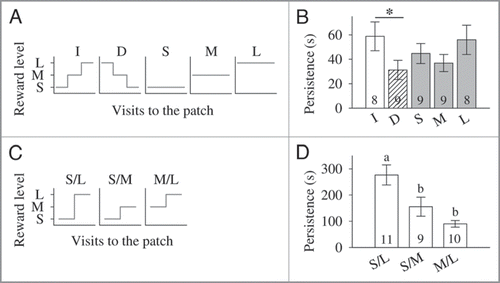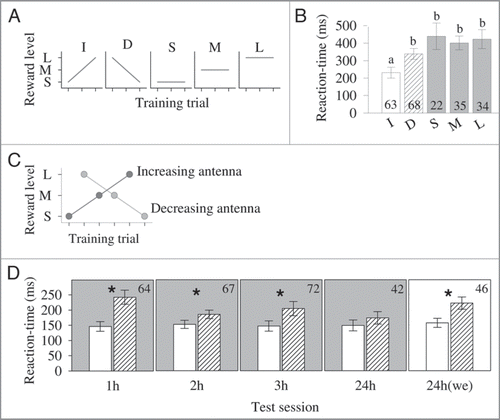Figures & data
Figure 1 (A) Reward schedules offered during training by the artificial flower patch in the first experiment.Citation12 Each bee collected either increasing (I, small-medium-large), decreasing (D, large-medium-small), small (S), medium (M), or large (L) reward levels throughout successive visits to the patch. (B) Persistence (mean ± s.e.m., in s) to search for food in the absence of reward 24 h after training for the five different reward schedules (increasing, I; decreasing, D; small, S; medium, M; and large, L). Asterisks indicate planned comparisons p < 0.05. (Modified from Gil et al.Citation12). (C) Increasing reward schedules offered during training by the artificial flower patch in the second experiment.Citation13 Each bee experienced either a large increase in reward level, from small to large (S/L), or a small increase in reward level, either from small to medium (S/M) or from medium to large (M/L). (D) Persistence (mean ± s.e.m., in s) to search for food in the absence of reward 24 h after training for the three different reward schedules (S/L, S/M and M/L). Different letters indicate LSD multiple comparisons p < 0.05 after one-way ANOVA. (Modified from Gil and De MarcoCitation13). (B, D) Number of tested bees is given within the bars.

Figure 2 Schematic representation of the effects of constant (grey lines), decreasing (blue lines), and increasing sugar reward levels (red and orange lines for either a large or small increase in reward level, respectively) on a honeybee’s foraging behavior. A built-in change detector computes differences in reward level across foraging events. This leads to the formation of a specific reward memory. In parallel, bees associate the reward with stimuli present at the food source (as the CS), and an associative memory is formed. After a long foraging pause, the reward’s related stimuli retrieve these two forms of memory. Associative and reward memories are evinced through honeybees’ choice behavior and foraging persistence, respectively. In this scheme, differences in persistence are interpreted as evidence of different expectations of reward.

Figure 3 (A) Reward schedules offered during training.Citation14 Each bee was presented with either increasing (I, small-medium-large), decreasing (D, large-medium-small), small (S), medium (M) or large (L) reward levels throughout three consecutive training trials (first, an antenna was stimulated with sucrose, and then, when the bee extended the proboscis it was fed with a given amount of sugar reward). (B) PE reaction-time (mean ± s.e.m., in ms, defined as the time between the stimulation of the antenna and the first movement of the proboscis) 24 h after training for the five different reward schedules (increasing, I; decreasing, D; small, S; medium, M; and large, L). Different letters indicate Dunn’s multiple comparisons p < 0.001. Number of tested bees is given within the bars. (Modified from Gil et al.Citation14) (C) Side-specific training in which the stimulation of each antenna was coupled with either increasing or decreasing reward levels.Citation15 Each antenna was stimulated three times in an alternate way. For example, in the 1st trial we stimulated the left antenna and fed the bee with a small reward; in the 2nd trial we stimulated the right antenna and fed the bee with a large reward; in the 3rd trial we stimulated the left antenna and fed the bee with a medium reward; and so on. (D) PE reaction-time (mean ± s.e.m.) following the stimulation of the antenna that was linked to increasing rewards (white bars) and the antenna that was linked to decreasing rewards (dashed bars). After training, the bees were divided into two groups. One group was tested four times (1, 2, 3 and 24 h after training) under extinction conditions (panels in gray), and the other group was tested only once 24 h after training (panel in white, “we” stands for without extinction). Asterisks indicate Wilcoxon signed-rank test p < 0.01. Number of tested bees is given in the upper right corner of each panel. (Modified from Gil et al.Citation15).

Figure 4 Schematic representation of the events involved in side-specific learning. When a honeybee experiences gustatory and mechanical stimulation of each antenna coupled with either increasing or decreasing rewards (red and blue lines, respectively) throughout consecutive training trials, a built-in change detector computes the differences in reward level associated with each antenna. This computation leads first to internal estimate of an expected reward associated to the input side (RwL, RwR), and then to side-specific reward memories. During memory retrieval, the combined stimulation of gustatory and mechanosensory receptors of the antenna (solid lines) activates both short- and long-term (ST, LT) side-specific reward memories. Mechanosensory stimulation of the antennae retrieves short-, and probably also long-term, side-specific reward memories (dashed lines). Specific gustatory input alone leads to the retrieval of long-term side-specific reward memories (dashed lines). The activation of such memories leads to side differences in a honeybee’s PE reaction-time, also evinced by the activity of the muscles M17s.
